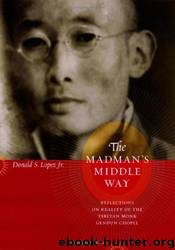The Madman's Middle Way: Reflections on Reality of the Tibetan Monk Gendun Chopel by Donald S. Lopez Jr

Author:Donald S. Lopez Jr.
Language: eng
Format: azw3
ISBN: 0226493164
Publisher: University Of Chicago Press
Published: 2005-12-15T00:00:00+00:00
Having thus dismissed the opinion of the majority and the authority of the enlightened as standards of truth, GC finally introduces the topic of pramana, valid knowledge. His hypothetical interlocutor says, "Since the mere agreement of the majority is not sufficient, it must be decided from the point of view of valid knowledge." A consciousness is considered valid if it perceives its object in a nondeceptive way; that is, it must perceive its object correctly. GC notes the circularity of this doctrine: one cannot decide whether the object is perceived correctly until one knows that the perceiving consciousness is valid; one cannot know whether the perceiving consciousness is valid until one knows that the object has been perceived correctly. "Therefore," he asks, "when does one decide?" Seeking to limit the possibility of error by calling in further forms of perception-looking at an object, touching it, asking a friend to look at it-in no way solves the problem, since each of these forms is subject to error. "For two people with bile disease, a yellow conch can be seen with their eyes and touched with their hands, and they both agree that it is yellow."
Having discredited all knowledge of the unenlightened as nothing more than opinion, GC concedes that this is our lot and that there is no alternative. "Therefore, as long as we remain in this land of samsara, it is true that there is no other method than simply making decisions, having placed one's confidence in this mind in which one can have no confidence in any of the decisions that it makes." The objects of our everyday experience are fictions, and we have no choice but to make decisions about them with our ignorant mind, which has created those fictions. What GC seems to find particularly irksome, however, is that the unenlightened are not content to limit their limited mind to the conventional world, but seem compelled to make all manner of grandiose statements about the ultimate, about the nature of reality, to give a name to all manner of supramundane qualities, each of which is beyond expression and beyond imagination.
GC concludes his discussion of the impossibility of valid knowledge by noting the range of opinion on the fundamental question of whether external objects exist apart from consciousness. He notes that the great fifth-century Theravada master Buddhaghosa-whose works were not translated into Tibetan and which GC encountered during his visit to Sri Lanka-stated that external objects exist. The Yogacara master Asanga said that external objects ("the imaginary") do not exist but that consciousness ("the dependent") does intrinsically exist. The Madhyamakas, however, said that even consciousness does not intrinsically exist. If these great masters could not agree on such a central question, what hope is there for the benighted?
Download
This site does not store any files on its server. We only index and link to content provided by other sites. Please contact the content providers to delete copyright contents if any and email us, we'll remove relevant links or contents immediately.
| Historic | Information Systems |
| Regional |
Man-made Catastrophes and Risk Information Concealment by Dmitry Chernov & Didier Sornette(5921)
The Revenge of Geography: What the Map Tells Us About Coming Conflicts and the Battle Against Fate by Kaplan Robert D(4035)
Zero Waste Home by Bea Johnson(3777)
COSMOS by Carl Sagan(3554)
Good by S. Walden(3485)
In a Sunburned Country by Bill Bryson(3481)
The Fate of Rome: Climate, Disease, and the End of an Empire (The Princeton History of the Ancient World) by Kyle Harper(3003)
A Wilder Time by William E. Glassley(2818)
Camino Island by John Grisham(2762)
The Ogre by Doug Scott(2631)
Organic Mushroom Farming and Mycoremediation by Tradd Cotter(2626)
Human Dynamics Research in Smart and Connected Communities by Shih-Lung Shaw & Daniel Sui(2465)
Energy Myths and Realities by Vaclav Smil(2438)
The Traveler's Gift by Andy Andrews(2409)
9781803241661-PYTHON FOR ARCGIS PRO by Unknown(2321)
Inside the Middle East by Avi Melamed(2305)
Birds of New Guinea by Pratt Thane K.; Beehler Bruce M.; Anderton John C(2224)
A History of Warfare by John Keegan(2186)
And the Band Played On by Randy Shilts(2129)
